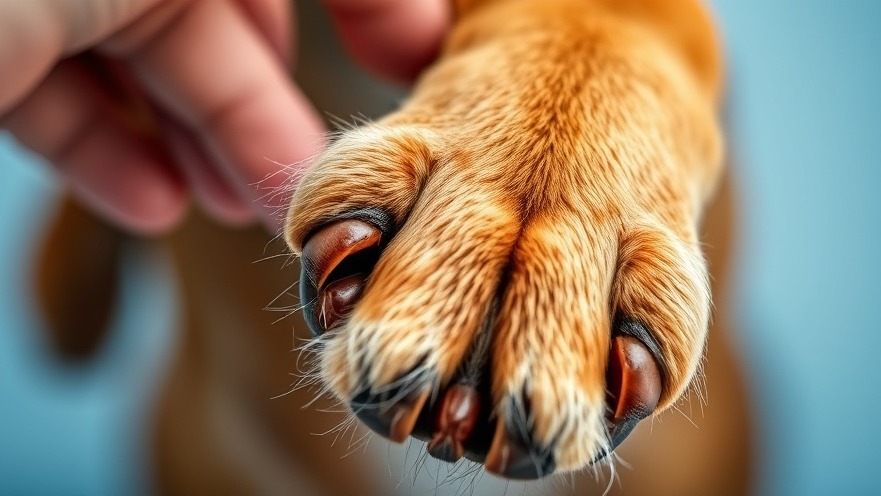
Understanding Your Dog's Paws: More Than Just Feet
Dog lovers understand that their furry friends' paws play a critical role in their well-being. Beyond simply being adorable appendages, a dog's paws provide cushioning to reduce stress on bones and joints, offer insulation in extreme weather, and protect against rough terrains. Unfortunately, many pet owners overlook the significance of maintaining paw health, which can lead to several issues. In this article, we will delve into the seven common dog paw problems, providing insights into preventative measures and treatments.
In 7 Common Dog Paw Issues and What to Do About Them, the discussion dives into prevalent challenges facing dog owners and their pets, exploring key insights that sparked deeper analysis on our end.
Common Symptoms of Paw Problems: What to Watch Out For
Before we dive into the specific issues, it's important to recognize the telltale signs of paw problems. Symptoms to look out for include excessive licking or chewing, limping, inflammation, hair loss, and foul odors. A dog's behavior can also change—more resting, less play—a clear indication that something might be wrong. Understanding these signals can empower you as a pet owner to seek timely vet assistance.
1. Allergies: Identifying and Managing Allergens
Allergies can affect dogs just as they do humans, manifesting primarily through itchy paws. Allergic reactions might arise from food or environmental triggers. Symptoms often include itchiness leading to incessant licking, resulting in further irritation and vulnerability to secondary infections. While completely preventing allergies is challenging, consulting a veterinarian can help pinpoint allergens and guide treatment options, which could involve dietary changes or medications.
2. Bacterial and Fungal Infections: Prevention and Treatment
If you notice redness, discharge, or brown discoloration on your dog's paws, it might indicate an infection. Bacteria and fungi can thrive on unattended paw wounds. Prompt and consistent cleaning can significantly reduce infection risks. Treatment may include antibiotics or topical creams; however, seeking a vet’s guidance is essential, especially if symptoms persist.
3. Parasites: The Hidden Menace
Ticks and mites lurking in the grass can wreak havoc on your dog's paws, causing pain and possible health complications. Regular grooming and the application of preventative treatments can keep your furry friend safe from infestations. Always check your dog for ticks after outdoor activities, especially in areas known for tick populations.
4. Nail Problems: Trimming for Health
Long or damaged nails can cause various issues for dogs. Not only do they pose pain during walks, but they can also lead to more serious injuries. Maintaining regular nail trims helps keep paws healthy and prevents nail-related pain. If you notice signs of ingrown nails or injuries, veterinary intervention may be needed.
5. Wounds and Cuts: First Aid for Your Dog
Paws endure a lot of wear and tear, particularly during outdoors adventures. Cuts and abrasions are common and should be treated immediately to avoid infection. Keep a dog-friendly first aid kit handy—cleaning wounds with antiseptics and applying pressure to stop bleeding are essential steps for home treatment.
6. Dry and Cracked Pads: Nourish and Protect
Environmental factors like extreme weather can dry out a dog’s paws. Dry or cracked pads could lead to painful conditions if not addressed. Keeping your dog's paws moisturized with balms can lessen the likelihood of severe issues, and in extreme conditions, consider protective booties to ensure comfort.
7. Burns: Keeping Paws Safe
Summer heat can lead to burns, while winter frostbite can harm paws, too. Chemicals like de-icing salts are also harmful. Keeping your dog off hot surfaces and using protective measures is essential. If burns occur, a vet visit is crucial for appropriate management.
Preventative Care: Proactive Strategies for Healthier Paws
Understanding your dog's paw health leads to a happier life for both you and your pet. Regular check-ups with your veterinarian, consistent grooming, and prompt attention to any visible issues can prevent many of these common paw problems. Investing in quality dog gear like protective booties can also help mitigate risks during outdoor excursions.
A Loving Reminder: Know When to Seek Help
Your dog's paws are a reflection of their overall health. If you observe any concerning symptoms or persistent issues, don't hesitate to consult your vet. Early intervention is key to ensuring your furry friend lives a joyous and healthy life. For further tips on canine paw health, explore additional resources available to dog owners.
In “7 Common Dog Paw Issues and What to Do About Them,” we explored the various challenges that our beloved pets may face regarding their paw health. This highlights not only the importance of monitoring their wellbeing but also the proactive measures we can take to maintain it.
 Add Row
Add Row  Add
Add 




Write A Comment